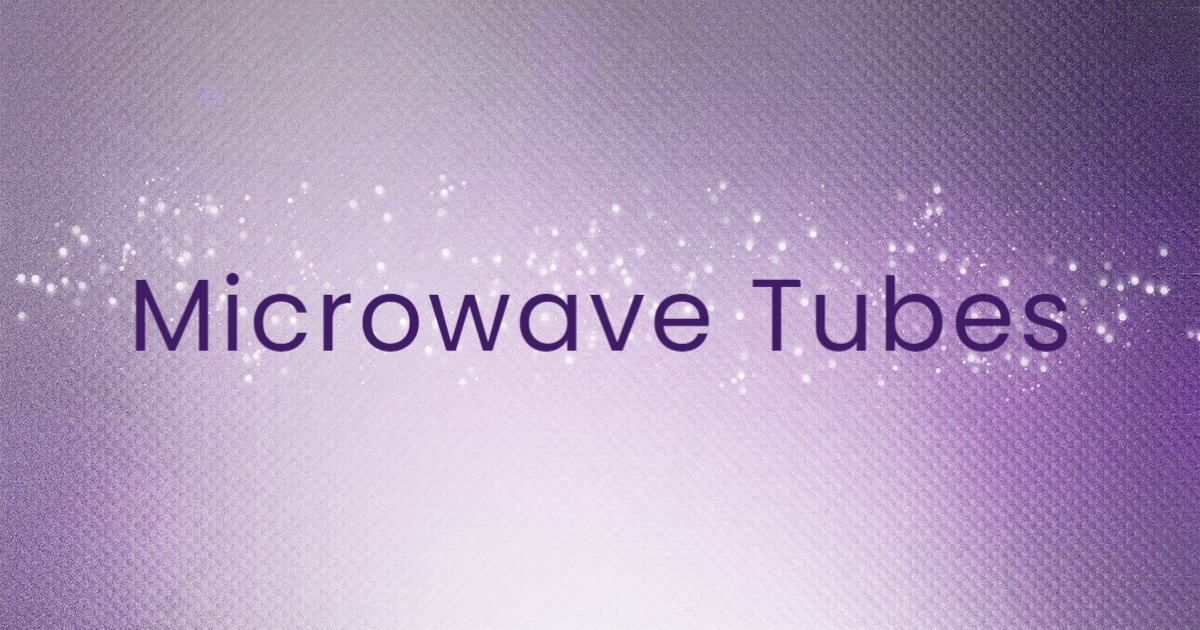Microwave Tubes
Microwave Tubes Intro
The microwave tubes use a Klystron amplifier that can magnify microwave signals by velocity modulation. Therefore, it forms high-velocity electrons with 30-45% efficiency reaching a max of 75% (0.5-6.4GHz). There is also Reflex Klystron for low power and low microwave oscillator efficiency. It has 4-200GHz, <10% efficiency, and TYP Po=100mW capacity. In contrast, the magnetron is a diode that uses magnetic and electric fields. It happens in a complex cavity to provide oscillations. Types include hole and slot, vane, rising sun, and coaxial. These have 10mW – UHF, 2mW – X-Band, 80KW – 95GHz, and 50-60% efficiency.
What are microwave tubes?
The types of microwave tubes include the traveling wave tube, cross-field amplifier, and backward wave oscillator. For the traveling tube, the beam and the RF field interact continuously. It can be used as a low-level, low-noise amplifier or high-power (CW or pulsed). The cross-field amplifier (CFA) is a cross between the TWT and Magnetron. Thus, the pulsed capacity is 1-18GHz, 5mW – UHF, 70%, 1mW – X-Band, 55%. However, the backward wave oscillator has a shorter and thicker TWT, 1 – 1000GHz microwave CW oscillator.
Semiconductor Microwave Devices
These include a transistor, a Parametric amplifier, and a Gunn diode. The transistor has 2-4GHz, 9W, 12-8dB, and 29.5-32.5db at 4-6GHz, and 15mW. FET – G=10dB, 9-15GHz, and F=7-14dB are other values. In contrast, the parametric amplifier uses a varying reactance device to result in amplification. The Gunn Diode uses the principle of the transferred electron effect. It is made of GaAs and InP. Other devices include Impact Avalanche & Transit Time Diode and Trapped Plasma Avalanche Triggered Transit Time Diode. Moreover, there are also the Tunnel, Varactor, Schottky Barrier, and PIN.
What is Waveguide?
It is a hollow metallic tube to propagate signals commonly from the 3-100GHz band. The Waveguide can transmit multiple signals using the same frequency but in different modes. Advantages of this tech include easier fabrication compared to a coaxial line, no flashover, better power handling, and lower power loss. Also, it has a higher operating frequency. Types include rectangular Waveguides with transverse electric with H-mode or transverse magnetic E-mode. The Dominant Mode has two types, mode yielding the longest cut-off wavelength and Circular Waveguide. The Circular Waveguide has a bigger cross-section and the possibility of the plane of polarization rotating due to roughness. It is easier to produce and join.
Other microwave devices are Ridged Waveguides and Flexible Waveguides. There is a single or double ridge type to lower the value of cut-off wavelength for Ridged Waveguide. It decreases the guide’s size, increasing the useful frequency range and reducing phase velocity. But it has a higher loss compared to an ordinary rectangular waveguide. Flexible Waveguides can be twisted, bent, or stretched, need no joins, and have almost the same power. Flange, Taper & Twist Sections, and Junctions are also microwave devices. Matching Sections include Iris, tuning screw, slide screw, Attenuator, slotted line, SWR meter, Isolator, Circulator, and Point Contact Diode.
Solving the Problem
The common one is finding the cut-off wavelength for the dominant mode in the rectangular Waveguide. It has a breadth of 10cm and a propagated signal of 2.5GHz. You must calculate the Guide Wavelength, the group, phase velocities, and characteristic wave impedance. Also, it is vital to reproduce a 10GHz signal in a Guide. The Guide’s wall separation is 6cm. So, find out the greatest number of Halfwaves of electric field intensity. For establishing between the two walls.
Download Resource

